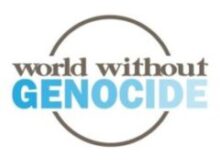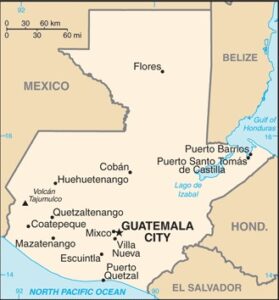Guatemala
What
In 1960, left-wing military officers led a failed revolt against the Guatemalan autocratic military government in efforts for reform, beginning a 36-year civil war. Over 200,000 Guatemalans were killed during this time, nearly 85% of whom were indigenous Mayans. [1] Over 40,000 people were forcibly disappeared, and public executions were common. [2] Nearly all human rights violations were perpetrated by the government’s forces. [3]
Where
Guatemala is located in Central America and is roughly the size of Tennessee. It has a population of over 18 million people, of which almost 45% identify as Mayan or another Indigenous demographic. [4] It is bordered by Mexico, Belize, Honduras, and El Salvador.
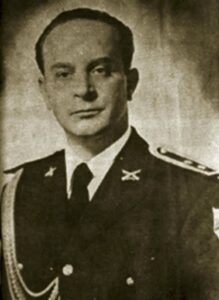
President Jacobo Árbenz made efforts to provide Indigenous people with land access and rights. Image courtesy of picryl is located in the public domain.
When
Coup d’état
In 1951, Jacobo Árbenz was democratically elected as president of Guatemala. He initiated plans for sweeping economic reforms to redistribute wealth more equally, including giving indigenous people access to land. Árbenz moved to nationalize the American corporation United Fruit Company, which controlled nearly half of Guatemala’s farmland. [5] That action, alongside his liberal leadership, became seen as a communist threat to American interests. [6] In 1954, U.S.-backed forces, led by Colonel Carlos Castillo Armas, ousted Árbenz from power and declared Castillo to be Guatemala’s president. [7] Armas reversed the land reforms that had benefited poor farmers and removed voting rights for illiterate Guatemalans. [8]
Revolutionary activist Che Guevara was in Guatemala when Árbenz’s administration fell, an event that further radicalized him. [9] The Guatemalan coup, and the violence it engendered, portended several similar events in neighboring Central American nations, which threw the region into decades of politically-motivated conflict over economic control of land and other resources. [10]
Military Rule
Decades of military rule in Guatemala provoked left-wing rebels to rise up against the government in 1960, which began the Guatemalan Civil War. [11] The government placed the country under siege, assaulted indigenous communities that were fighting for indigenous rights, and killed tens of thousands of civilians in attempts to suppress guerilla insurgencies. [12]
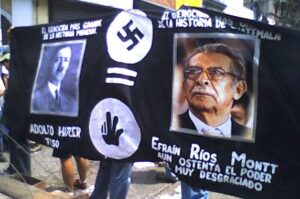
A protester compares Efraín Ríos Montt to Hitler. Image courtesy of Firetreo is cropped and is located in the public domain.
General Efraín Ríos Montt seized power in a military coup in 1982. He suspended political parties, dissolved Congress, and annulled the 1965 constitution. [13] That same year, the guerrilla movement formed the Guatemalan National Revolutionary Unity (URNG). [14] Montt formed organizations called “civilian defense patrols,” which helped enact his scorched-earth policy against the URNG. The patrols burned Mayan villages to the ground and exterminated inhabitants to reclaim territory. [15] During this period, approximately “200,000 people were killed or disappeared, 1.5 million were displaced, and over 150,000 were driven to seek refuge in Mexico.” [16] Reports show that the state perpetrated over 90% of this violence and that over 80% of the victims were Mayan. [17]
Conflict persisted through the late 1980s and early 1990s, despite efforts to reform the state. In 1994, peace talks between URNG rebels and the government began under President Ramiro de León Carpio, a former human rights ombudsman. [18] Although negotiations took two years to finalize, peace accords were signed in 1996, ending the 36-year war. [19]
How
Across the conflict, the military used mass expulsion, forced disappearances, rape, torture, and murder against civilians. [20] It targeted indigenous communities because they were considered recruiting grounds for guerrillas, with the government’s goal to completely wipe out those collectives. [21] The government forces attacked students, intellectuals, priests, leftists, and anyone in opposition to the military and wealthy land-owning elite. [22] Victims were often tortured, executed, and disposed of in mass graves. [23] While investigators have exhumed some graves, thousands of Guatemalans still do not know what happened to their relatives. [24]
U.S. Involvement
The United States supported Guatemala’s successive military governments as they committed genocide against the Indigenous population. [25] American corporate interests within Guatemala became threatened by efforts to redistribute land to peasants and indigenous farmers, with U.S. leaders fearing an eventual communist take-over in the country. These corporations used government connections and propaganda campaigns framing President Árbenz as a communist dictator to convince the U.S. government to overthrow his regime. [26]
After the coup, the US continued funding Guatemala until President Jimmy Carter halted all military aid in 1977 due to Guatemala’s human rights abuses. [27] However, existing corporate contracts were exempt from the ban and U.S. money continued to flow to the Guatemalan government. [28] The Reagan administration increased aid from $11 million to $104 million, citing human rights improvements despite the 1980s being one of the deadliest periods of the genocide. [29] Nearly all financial assistance went to Guatemalan military units in the rural highlands where Mayans were most targeted. [30]
Response
Media failed to cover U.S. government involvement during the genocide. Limited U.S. press coverage of the genocide portrayed the guerrilla movement as dangerous communists. [31] Indigenous people were falsely blamed as the perpetrators of massacres carried out by the government. [32]
In 1994, the United Nations became involved in brokering a peace deal between the government and the indigenous guerrillas, and in 1996, the Accord for a Firm and Lasting Peace was signed by the URNG and the Guatemalan government. [33]
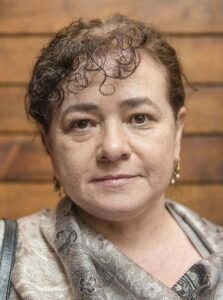
Claudia Paz y Paz. Image courtesy of EneasMX is unmodified and licensed under CC BY-SA 4.0.
Justice Process
In 2010, Guatemala appointed Claudia Paz y Paz as its Attorney General. She was the first woman to hold the position and began the domestic justice process against perpetrators of the Guatemalan genocide of Indigenous populations. [34] In 2012, Paz y Paz indicted former President Efraín Ríos Montt for his role in the ‘scorched earth’ campaign of the 1980s. [35] He was the first head of state to face genocide charges in his own country. [36] Paz y Paz was instrumental in getting rape tried as a war crime, giving a voice to the estimated 100,000 women raped during the genocide. [37]
In 2013, Montt was found guilty of genocide for his role in the massacres of more than 1,700 indigenous Ixil Mayans. [38] Ten days later, Guatemala’s Constitutional Court annulled the conviction and ordered a retrial. [39] The next year, the Constitutional Court forced Paz y Paz out of her position. [40] The retrial eventually began behind closed doors, but Montt died in 2018 before a verdict was reached. [41] Montt’s Chief of Military Intelligence Mauricio Rodríguez Sánchez was also tried for genocide, but the Constitutional Court acquitted Sánchez in 2018. [42]
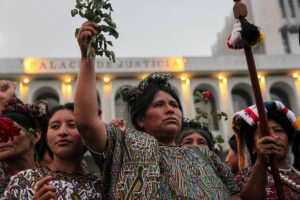
Ixil women celebrate after Ríos Montt was found guilty of genocide. Image courtesy of Trocaire is unmodified and licensed under CC BY 2.0.
Paz y Paz also arrested military officials and members of Guatemala’s most powerful gangs on war crime accusations. [43] She extradited local drug trafficking bosses to the US to face prosecution. [44] Her term symbolized a new kind of justice for Central America and resulted in many threats to her safety. (She received the 2016 ‘Outstanding Upstander’ award from World Without Genocide. See photo from the ceremony here).
Guatemala prosecuted some human rights and corruption cases with help from the UN-backed International Commission against Impunity in Guatemala (CICIG), which opened in 2006. [45] The CICIG encountered backlash for its work and in 2019, Former President Morales did not renew its mandate. [46] This closure allows for ongoing persecution of anti-corruption forces, human rights defenders, and journalists by state and non-state parties in the country. [47]
Human rights prosecutions continue in Guatemala’s court system, though they face delays, interference from Guatemalan political actors, and contested acquittals. [48] Legislators tried several times over the past decade to pass a general amnesty bill pardoning those accused of war crimes during Guatemala’s civil war, but the Inter-American Court of Human Rights struck down each attempt. [49]
Today
Today, criminal organizations have impunity for violence and extortion. [50] Very few accused perpetrators are convicted of murder, and Guatemala has the world’s eighth–highest rate of femicide, the murder of women by a male partner, ex-partner, or family member. [51]
Indigenous Communities
Disproportionate maternal mortality, unemployment, and poverty affect Guatemalan Indigenous communities, alongside systemic discrimination and political underrepresentation. [52] Widespread linguistic marginalization hinders Indigenous societal equality, with government services failing to provide non-Spanish-speaking Indigenous individuals with the translation resources needed to access healthcare, voting, and more. [53] Indigenous faith is also targeted, and individuals are prohibited entry to religious sites. [54] Few mechanisms exist for Indigenous peoples to convey their social, economic, and territorial concerns to the state. [55]
Guatemala detains Indigenous activists who fight for greater communal rights, frequently through manipulated charges, and several such advocates have been killed. [56] While law requires the government to consult with Indigenous Guatemalans about infrastructure projects on their lands, these imperatives are not upheld. [57] These economic projects often exacerbate existing inequalities within Indigenous communities, including environmental degradation, illness, water shortages, and a lack of adequately-nutritious food resulting in high rates of childhood malnutrition. [58] Indigenous individuals report forced removals from ancestral lands by private landowners and local actors, with little government intervention. [59]
Future
Center-left and anti-corruption candidate Bernardo Arévalo won the 2023 presidential election. Incumbent officials, supported by wealthy elites, interfered with the election process. [60] Since assuming office, Arévalo has faced significant institutional challenges to dismantle corruption within the government. [61] He has, for instance, been unable to dismiss Attorney General Consuelo Porras from her position, despite her pivotal rule in trying to de-certify his presidential win. [62] Non-governmental organizations and indigenous groups continue to push for greater governmental accountability and redress for past human rights violations.
This page was updated by Bekir Hodzic, January 2025.
References
[1] Sanford, V. (n.d.). Violence and Genocide in Guatemala. MacMillan Center for International and Area Studies at Yale: Genocide Studies Program. https://macmillan.yale.edu/gsp/publications/pathways-protection
[2] Cuffe, S. (2019, August 30). Day of the Disappeared: ‘The pain never ends’ in Guatemala. Al Jazeera. https://www.aljazeera.com/features/2019/8/30/day-of-the-disappeared-the-pain-never-ends-in-guatemala
[3] Tomuschat, C., de Cotí, O. L., & Tojo, A. B. (February 1999). Guatemala: Memory of Silence. Commission for Historical Clarification. https://hrdag.org/wp-content/uploads/2013/01/CEHreport-english.pdf
[4] Central Intelligence Agency. (2024, December 20). Guatemala. The World Factbook. https://www.cia.gov/the-world-factbook/countries/guatemala/
[5] Gleijeses, P. (October 1989). The Agrarian Reform of Jacobo Arbenz. Journal of Latin American Studies, 21(3), 453-480. https://www.jstor.org/stable/156959
[6] Streeter, S. M. (November 2000). Interpreting the 1954 U.S. Intervention in Guatemala: Realist, Revisionist, and Postrevisionist Perspectives. The History Teacher, 34(1), 61-74. https://www.jstor.org/stable/3054375
[7] Bowen, G. L. (Winter 1983). U.S. Foreign Policy toward Radical Change: Covert Operations in Guatemala, 1950-1954. Latin American Perspectives, 10(1), 88-102. https://www.jstor.org/stable/2633365
[8] Timeline: Guatemala’s Brutal Civil War. (2011, March 7). PBS News. https://www.pbs.org/newshour/health/latin_america-jan-june11-timeline_03-07
[9] Che Guevara (1928-1967). (n.d.). PBS: American Experience. Accessed January 6, 2024, from https://www.pbs.org/wgbh/americanexperience/features/castro-che-guevara-1928-1967/; Anderson, J. L. (2010). Che Guevara: A revolutionary life (revised edition). Grove Press.
[10] Coleman, K. M. & Herring, G. C. (eds). (1991). Understanding the Central American crisis: Sources of conflict, U.S. policy, and options for peace. SR Books. http://ereserve.library.utah.edu/Annual/POLS/5490/Epstein/reagan.pdf
[11] Oster, R. (March 2024). Study of Internal Conflict Case Studies: Guatemalan Civil War 1960–96. Strategic Studies Institute: U.S. Army War College. https://ssi.armywarcollege.edu/Research-Commentary/Study-of-Internal-Conflict/SOIC-Conflict-Studies/
[12] Tomuschat, C., de Cotí, O. L., & Tojo, A. B. (February 1999). Guatemala: Memory of Silence. Commission for Historical Clarification. https://hrdag.org/wp-content/uploads/2013/01/CEHreport-english.pdf
[13] Timeline: Guatemala’s Brutal Civil War. (2011, March 7). PBS News. https://www.pbs.org/newshour/health/latin_america-jan-june11-timeline_03-07
[14] Horst, O. H., Stansifer, C. L., Griffith, W. J., & Anderson, T. P. (2025, January 4). Guatemala. Encyclopedia Britannica. https://www.britannica.com/place/Guatemala
[15] Doyle, K. (2013, May 9). The Final Battle: Ríos Montt’s Counterinsurgency Campaign. The National Security Archive. https://nsarchive2.gwu.edu/NSAEBB/NSAEBB425/
[16] Sanford, V. (n.d.). Violence and Genocide in Guatemala. MacMillan Center for International and Area Studies at Yale: Genocide Studies Program. https://macmillan.yale.edu/gsp/publications/pathways-protection
[17] Sanford, V. (n.d.). Violence and Genocide in Guatemala. MacMillan Center for International and Area Studies at Yale: Genocide Studies Program. https://macmillan.yale.edu/gsp/publications/pathways-protection
[18] Castellanos, A. (1994, January 11). Guatemalan president welcomes agreement to continue peace talks. UPI. https://www.upi.com/Archives/1994/01/11/Guatemalan-president-welcomes-agreement-to-continue-peace-talks/7181758264400/
[19] The Associated Press. (2018, April 30). Álvaro Arzú, Ex-President of Guatemala, Dies at 72. The New York Times. https://www.nytimes.com/2018/04/30/obituaries/alvaro-arzu-ex-president-of-guatemala-dies-at-72.html
[20] Guatemalan Genocide. (n.d.). USC Shoah Foundation. https://sfi.usc.edu/collections/guatemalan
[21] Tomuschat, C., de Cotí, O. L., & Tojo, A. B. (February 1999). Guatemala: Memory of Silence. Commission for Historical Clarification. https://hrdag.org/wp-content/uploads/2013/01/CEHreport-english.pdf
[22] Tomuschat, C., de Cotí, O. L., & Tojo, A. B. (February 1999). Guatemala: Memory of Silence. Commission for Historical Clarification. https://hrdag.org/wp-content/uploads/2013/01/CEHreport-english.pdf
[23] Rodríguez, J. (2021, May 22). Guatemala disappeared: Reuniting families with the remains of loved ones. BBC. https://www.bbc.com/news/world-latin-america-57133013
[24] Rodríguez, J. (2021, May 22). Guatemala disappeared: Reuniting families with the remains of loved ones. BBC. https://www.bbc.com/news/world-latin-america-57133013
[25] Isaacs, A. (2013, May 19). We Enabled Guatemalan Genocide, but the Elite Committed It. The New York Times. https://www.nytimes.com/roomfordebate/2013/05/19/what-guilt-does-the-us-bear-in-guatemala/we-enabled-guatemalan-genocide-but-the-elite-committed-it
[26] Táíwò, O. O. (2021, December 7). When the United Fruit Company Tried to Buy Guatemala. The Nation. https://www.thenation.com/article/economy/united-fruit-guatemala/; Kurtz-Pelan, D. (2008, March 2). Big Fruit. The New York Times. https://www.nytimes.com/2008/03/02/books/review/Kurtz-Phelan-t.html
[27] Grandin, G. (2013, May 21). Guatemalan Slaughter Was Part of Reagan’s Hard Line. The New York Times. https://www.nytimes.com/roomfordebate/2013/05/19/what-guilt-does-the-us-bear-in-guatemala/guatemalan-slaughter-was-part-of-reagans-hard-line
[28] Grandin, G. (2013, May 21). Guatemalan Slaughter Was Part of Reagan’s Hard Line. The New York Times. https://www.nytimes.com/roomfordebate/2013/05/19/what-guilt-does-the-us-bear-in-guatemala/guatemalan-slaughter-was-part-of-reagans-hard-line
[29] Grandin, G. (2013, May 21). Guatemalan Slaughter Was Part of Reagan’s Hard Line. The New York Times. https://www.nytimes.com/roomfordebate/2013/05/19/what-guilt-does-the-us-bear-in-guatemala/guatemalan-slaughter-was-part-of-reagans-hard-line
[30] Grandin, G. (2013, May 21). Guatemalan Slaughter Was Part of Reagan’s Hard Line. The New York Times. https://www.nytimes.com/roomfordebate/2013/05/19/what-guilt-does-the-us-bear-in-guatemala/guatemalan-slaughter-was-part-of-reagans-hard-line
[31] Counterspin & Nairn, A. (1999, May 1). On Guatemala, ‘The Press Has Blood on Its Hands’. Fairness & Accuracy in Reporting. https://fair.org/extra/on-guatemala-the-press-has-blood-on-its-hands/
[32] Counterspin & Nairn, A. (1999, May 1). On Guatemala, ‘The Press Has Blood on Its Hands’. Fairness & Accuracy in Reporting. https://fair.org/extra/on-guatemala-the-press-has-blood-on-its-hands/
[33] UN and Guatemala peace process. (n.d.). United Nations. https://www.un.org/en/yearbook/un-and-guatemala-peace-process
[34] Bailey, C. (2016). Transforming Justice in Guatemala: Strategies and Challenges Investigating Violent Deaths 2011-2014. Georgetown Institute for Women, Peace and Security. https://giwps.georgetown.edu/resource/justice-in-guatemala/
[35] Wolfe, L. (2012, February 10). Reckoning With a Genocide in Guatemala. The Atlantic. https://www.theatlantic.com/international/archive/2012/02/reckoning-with-a-genocide-in-guatemala/252761/
[36] Rios Montt Guatemala genocide retrial suspended. (2015, January 5). BBC. https://www.bbc.com/news/world-latin-america-30678693
[37] Wolfe, L. (2012, February 10). Reckoning With a Genocide in Guatemala. The Atlantic. https://www.theatlantic.com/international/archive/2012/02/reckoning-with-a-genocide-in-guatemala/252761/
[38] MacLean, E. (November 2013). Judging a Dictator: The Trial of Guatemala’s Ríos Montt. Open Society Justice Initiative. https://www.justiceinitiative.org/publications/judging-dictator-trial-guatemala-s-rios-montt
[39] Justice on Trial in Guatemala: The Ríos Montt Case. (2013, September 23). International Crisis Group. https://www.crisisgroup.org/sites/default/files/justice-on-trial-in-guatemala-the-rios-montt-case.pdf
[40] Sanz, J. L. (2014, August 15). Guatemala: The Fall of Paz y Paz, the End of a Judicial Awakening. InSight Crime. https://insightcrime.org/news/analysis/paz-y-paz-end-guatemala-judicial-awakening/
[41] Burt, J. & Estrada, P. (2018, April 13). Legacy of Guatemala Dictator Ríos Montt Shows Justice is Possible. Washington Office on Latin America. https://www.wola.org/analysis/legacy-guatemala-dictator-rios-montt-shows-justice-possible/
[42] Burt, J. (2018, October 12). Imperfect Justice in Guatemala. North American Congress on Latin America. https://nacla.org/news/2018/10/12/imperfect-justice-guatemala
[43] Fausset, R. (2013, January 5). Guatemala official takes on nation’s ugly past, violent present. Los Angeles Times. https://www.latimes.com/world/la-xpm-2013-jan-05-la-fg-guatemala-paz-20130106-story.html
[44] Sanz, J. L. (2014, August 15). Guatemala: The Fall of Paz y Paz, the End of a Judicial Awakening. InSight Crime. https://insightcrime.org/news/analysis/paz-y-paz-end-guatemala-judicial-awakening/
[45] Schneider, M. L. (2019, April 11). Democracy in Peril: Facts on CICIG in Guatemala. Center for Strategic and International Studies. https://www.csis.org/analysis/democracy-peril-facts-cicig-guatemala
[46] Cuffe, S. (2019, September 1). Guatemala’s anti-corruption CICIG body to shut down: What to know. Al Jazeera. https://www.aljazeera.com/news/2019/9/1/guatemalas-anti-corruption-cicig-body-to-shut-down-what-to-know
[47] Neau, A. & Salomon, J. (2023, November 22). It’s hunting season against justice officials in Guatemala. Amnesty International. https://www.amnesty.org/en/latest/news/2023/11/hunting-season-against-justice-officials-guatemala/; Guatemala. (n.d.). Freedom House. https://freedomhouse.org/country/guatemala/freedom-world/2024
[48] 2023 Country Reports on Human Rights Practices: Guatemala. (n.d.). U.S. Department of State. https://www.state.gov/reports/2023-country-reports-on-human-rights-practices/guatemala/; Guatemala: Concern over transitional justice setbacks. (2024, December 6). Centro Pro La Justicia Y El Derecho Internacional. https://cejil.org/en/press-releases/guatemala-concern-over-transitional-justice-setbacks/
[49] Riederer, J. (2023, November 2). IACHR Rules Guatemala Must Halt Legislative Action on Bills Providing Amnesty to Perpetrators of Human Rights Abuses. Impunity Watch. https://impunitywatch.com/iachr-rules-guatemala-must-halt-legislative-action-on-bills-providing-amnesty-to-perpetrators-of-human-rights-abuses/
[50] Papadovassilakis, A. (2024, March 12). Anti-Corruption Commission Confronts Guatemala’s ‘Continuum of Impunity’. Insight Crime. https://insightcrime.org/news/interview/anti-corruption-commission-confronts-guatemala-continuum-impunity/
[51] Analysis of the State of homicidal violence in Guatemala. January-December 2023. (2024, February 16). InfoSegura. https://infosegura.org/en/guatemala/analysis-state-homicidal-violence-guatemala-january-december-2023; World Bank. (2023, May 30). Gender-Based Violence Country Profile: Guatemala. World Bank Group. https://documents.worldbank.org/en/publication/documents-reports/documentdetail/099053023161523435/p1769790c58ba10f0a5830bf75b650f968
[52] The Indigenous World 2024: Guatemala. (2024, March 22). International Work Group for Indigenous Affairs. https://www.iwgia.org/en/guatemala/5384-iw-2024-guatemala.html; 2023 Country Reports on Human Rights Practices: Guatemala. (n.d.). U.S. Department of State. https://www.state.gov/reports/2023-country-reports-on-human-rights-practices/guatemala/
[53] 2023 Country Reports on Human Rights Practices: Guatemala. (n.d.). U.S. Department of State. https://www.state.gov/reports/2023-country-reports-on-human-rights-practices/guatemala/
[54] 2023 Report on International Religious Freedom: Guatemala. (n.d.). U.S. Department of State. https://www.state.gov/reports/2023-report-on-international-religious-freedom/guatemala/
[55] 2023 Country Reports on Human Rights Practices: Guatemala. (n.d.). U.S. Department of State. https://www.state.gov/reports/2023-country-reports-on-human-rights-practices/guatemala/
[56] Tucker, D. (2021, November 15). The Mayan teacher locked up for defending a sacred river. Amnesty International. https://www.amnesty.org/en/latest/news/2021/11/mayan-teacher-locked-up-defending-sacred-river/; Martin, M. (2019, January 22). Killings Of Guatemala’s Indigenous Activists Raise Specter Of Human Rights Crisis. NPR. https://www.npr.org/2019/01/22/685505116/killings-of-guatemalas-indigenous-activists-raise-specter-of-human-rights-crisis
[57] 2023 Country Reports on Human Rights Practices: Guatemala. (n.d.). U.S. Department of State. Accessed January 6, 2024, from https://www.state.gov/reports/2023-country-reports-on-human-rights-practices/guatemala/
[58] The Indigenous World 2024: Guatemala. (2024, March 22). International Work Group for Indigenous Affairs. https://www.iwgia.org/en/guatemala/5384-iw-2024-guatemala.html
[59] 2023 Country Reports on Human Rights Practices: Guatemala. (n.d.). U.S. Department of State. Accessed January 6, 2024, from https://www.state.gov/reports/2023-country-reports-on-human-rights-practices/guatemala/
[60] Guatemalans protest interference by court, prosecutors in August’s second-round election. (2023, July 24). AP News. https://apnews.com/article/guatemala-presidential-election-protests-interference-65d18ec0960effac8463e018579fa1a3
[61] Díaz, J. A. (2024, August 9). With President Arévalo’s hands tied, Guatemala’s Indigenous communities are increasingly losing hope. Equal Times. https://www.equaltimes.org/with-president-arevalo-s-hands?lang=en
[62] Díaz, J. A. (2024, August 9). With President Arévalo’s hands tied, Guatemala’s Indigenous communities are increasingly losing hope. Equal Times. https://www.equaltimes.org/with-president-arevalo-s-hands?lang=en
